(SO - speleological section)
-
SO HPD "Biokovo",
Makarska
-
Dinaridi-Društvo
za istraživanja i snimanja krških fenomena, Zagreb
-
SO PD "Dubovac",
Karlovac
-
SO HPD "Dubrovnik",
Dubrovnik
-
Speleološko društvo "Đula-Medvedica", Ogulin
-
Speleološko-alpinistički klub Ekstrem, Makarska
-
SO HPD
"Imber", Omiš
-
SO HPD "Imotski", Imotski
-
SO HPD "Japetić",
Samobor
-
SO HPD "Kamenar",
Šibenik
-
SU "Kraševski
zviri", Ivanec
-
SO "Liburnija" PD "Paklenica",
Zadar
-
Speleološko društvo Lika, Gospić
-
SO HPD "Malačka-Donja Kaštela",
Kaštel Stari
-
SO PD "Mališćak",
Velika
-
SO HPD "Mosor",
Split
-
SO PD
"Promina", Drniš
-
SO PD
"Profunda", Brač
-
SO HPD
"Sniježnica", Cavtat
-
SO PK "Split",
Split
-
SO HPK "Sveti Mihovil",
Šibenik
-
SO PDS "Velebit",
Zagreb
-
SO HPD "Željezničar",
Zagreb
Web links,
addresses and contact persons

Emergency phone number:
112
Tourist caves (Show caves) in Croatia
THE SPELEOLOGICAL COMMITTEE
Speleological Committee is a body of the
Croatian Mountaineering Association. It coordinates activities of caving clubs
in Croatia, provides permissions for speleological explorations, and has
important role in speleological education (speleological schools, seminars,
speleological exams and titles, publications).
The Committee was founded in 1956. Today, the
Committee has 19 members - speleological sections of mountaineering club and
speleological societies that are members of Croatian Mountaineering Association.
Until today, members of the Committee have explored several thousands of
caves and pits. Explorations on expeditions in Croatia and abroad are
very important activity. Results of explorations of deep caves are recognized on
world level.
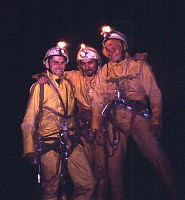
Lukina jama. After a week of advance down
in a pit, on August 7th 1993. at 21:45, a
team: Damir Lacković (SOV), Siniša Rešetar (SOV) and
Robert Dado (SOŽ), first reached the bottom at - 1355 m.
Foto: D.Lacković
One of basic tasks of the Committee is education of cavers, which is currently
done through speleological schools, seminars, exams for title caver and seminars
for instructors. First speleological course was organised in 1957 in Ogulin,
followed by course in Donja Cerovačka cave in 1958 and course in Tounj in 1960.
Organisation of speleological schools according to program developed by the
Committee started in 1966. Since the start of Zagreb speleological school in
1971, the schools are organised annually in Zagreb, Split, Karlovac, Šibenik and
other cities. In order to improve knowledge in certain areas the seminars are
regularly organised. Members of the Committee participate in meetings and
seminars abroad. Publication of several publications and textbooks for
speleological education was supported by the Committee. Until 2008., under the
Committee’s authority 44 people acquired title of instructor of speleology
and 163 title of caver. About 80 trainees of speleology are educated in
speleological schools each year.
Speleological Committee cooperates with Croatian speleological association,
Croatian biospeleology society, national and natural parks, as well as with
scientific and professional institutions. Certain numbers of cavers are active
in Croatian Mountain Rescue Service, especially in its Speleo-Rescue Commission.
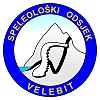
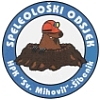






|
|
Caving
Clubs in Croatia
contacts and links to club's
web sites Official list of the
deepest and longest caves in Croatia
Velebita
pit
513 m underground vertical
cave is -1026 m deep
Lukina jama-Trojama
deepest Croatian cave -1392 m
Slovačka
jama
last exploration: -1320 m
Patkov gušt
553 m vertical
Amfora pit
deepest cave on Biokovo mountain,
-788 m
Photo documentation:
Expeditions to Lukina jama and Slovačka jama - Velebit, Croatia
Cave system
Djula- Medvedica
16396 m
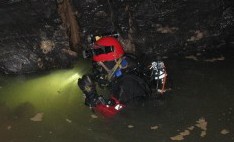
Results of speleological
expedition
"Lukina jama 2010"
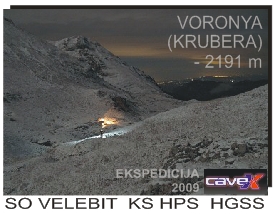

Dachstein-Mammuthöhle
INFORMATION FOR FOREIGN VISITORS TO CROATIAN CAVES
Here you can find the information about the
possibility of visits or joining the explorations of Croatian caves.
According to the Law of nature
protection (Zakon o zaštiti prirode, Narodne novine 70/05), you can
not enter any cave in Croatia without written permission, except
tourist
caves (show caves). In the caves you can not take with you any geological or
biological sample without the written permission of the Croatian
Ministry of Science, Education and Sports.
ENDANGERED KARST PHENOMENA
The longest Croatian cave, more than 16 km long cave system
Đulin
ponor-Medvedica situated under town Ogulin and 8.5 km long cave
Špilja u
kamenolomu Tounj are among the most endangered karst phenomena in Croatia. One
of the activities of Speleological Committee is stimulation of protection of
speleological objects and karst underground as well as informing about it.
SPELEOLOGICAL EXPLORATIONS
Explorations of deep pits
started in 1957 when pit Čudinka (depth 203 m) was explored. In 1961 on South
Velebit a speleo camp was organised and 195 m deep pit Vrtlina was explored. In
1975 on cave expedition in pit Puhaljka the depth of 318 m was reached. In pit
Ponor Bunovac in 1977 the depth of 534 m was reached making it first pit deeper
than 500 m in Croatia. In 80s several deep pits had been explored on Biokovo.
Expeditions to pit Lukina jama in National park North Velebit were organised in
period 1993-1995. The pit was named after Ozren Lukić-Luka, the caver that got
killed on Velebit as Croatian solider in homeland war. Cave system Lukina
jama—Trojama is explored to the depth of 1392 m which made it 9th deepest pit in
the world at that time, and is still the deepest cave in Croatia. In 1994 on the
depth of 1349 m Zoran Stipetić-Patak and Teo Barišić dived through 57 m long and
6 m deep siphon in at that time the cave dive on biggest depth in the world.
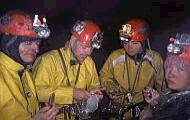
In Slovačka jama, 1320 m deep pit on North Velebit, it was explored in period
1995-2002. In Amfora located on Biokovo the exploration lasted in period
1998-2002. In 2003 pit Velebita was discovered in National park North Velebit,
where during last years the depth of -1026 m was reached and the exploration
still lasts. Velebita is today 3rd deepest Croatian cave. In Velebita,
the
world’s longest vertical was found with the length of 513 m.
Until today, 14 pits deeper than 500 m were explored in Croatia.
First expedition abroad was organised in 1982 to 1160 m deep pit Berger in
France. It was followed by expeditions to Morocco in 1983, to Turkey in 1985, to
Picos de Europa, Spain in 1986, to Austria in 1990, to South America in 1995, to
Mexico in 1997, 1999, 2004, to Madagascar in 2001, to Laos in 2002, to pit Jean
Bernard in France in 2002 and 2003, and to Cuba in 2004/2005.
During expedition to pit Lukina Jama in 1994 Ana Bakšić found new animal specie,
endemic leech
Croatobranchus mestrovi. The leech was later found only in few deepest
pits on Velebit.
HOW MANY CAVES HAVE BEEN DISCOVERED IN CROATIA?
In 2006. Croatian speleological
clubs started to collect and exchange the data about speleological
explorations in Croatia, and there are about 9500 records of
speleological explorations. But at this point we can not give the
number of caves and pits, because bigger caves have more than one
record, and there are also numerous overlappings of explorations.
Thorough field work and checking the data is needed to get the
proper number of explored caves. After that a cadastre of caves can
be formed. Some National parks and Nature parks have their own
cadastre, that were made by Croatian speleologists (NP Sjeverni
Velebit, NP Risnjak, NP Paklenica, PP Žumberak-Samoborsko gorje
etc.).
The data about the deepest and
longest caves and pits in Croatia are better known and presented in
the list of the biggest Croatian caves.
There are 49 pits deeper than 250 m, 14 of them are deeper than 500
m and three deeper than 1000 m. The deepest Croatian pits are mostly
found in two regions - Mt. Velebit and Mt. Biokovo.
FROM THE HISTORY OF CROATIAN
SPELEOLOGY
In 1096. The oldest
written document about caves in Croatia is the church document dated
back in year 1096., more than nine hundred years ago. The document
describes borders of the monastery "Sv. Krševana" on the island
Ugljen and is written in Latin. The first word used for a cave is
PECHICE, and has a Slavonic root. The cave was explored in 1952, by
Mirko Malez. The same cave is mentioned again in various documents
in 1166, 1652, 1737 and in 1716, when is drown on a map.
In 1584.
Nikola Vitov
Gucetić, was the author of the first
speleological scientific dissertation in Croatia.
In 1886.
The committee for the preparation of the
tourist part of Samograd cave (Perušić) was founded, that is the first
speleological society in Croatia.
In 1900. The first caving club in
Croatia, Speleological section "Liburnija", Zadar was founded. In 1903
they organized the first Croatian speleological expedition on
Kornati islands. In 1908. in "Liburnija", the scientific committee for cave
exploration was founded.
In 1910. Dragutin
Gorjanović Kramberger founded The committee for the cave exploration
in The geological committee of Kingdom of Croatia and Slavonia. That
is the first professional speleological society in Croatia.
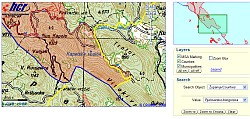

MISportal of the Croatian
Mine Action Centre was put into trial operation. The portal will be
providing insights into the status of mine suspected areas of the Republic
of Croatia. Unfortunately, maps do not have coordinates, so the use of this
data is limited, and not very useful for a field.
The costs of MISportal project are covered
by the donation of the Kingdom of Norway.
Be careful! Please inform yourself about
the areas with mines! |
|
THE AIMS OF THE SPELEOLOGICAL COMMITTEE
Speleological education
speleological schools, seminars, speleological exams
and speleological titles
Permissions for speleological explorations
Coordination and co-financing of
speleological explorations
Visits of foreign
speleologists
Cooperation with UIS, and Croatian institutions
and societies.

Croatia is a member of UIS, FSE and BSU.
Cave and karst science.
The protection of karst phenomena.
Cave conservation.
Exchange and publication of the results of
speleological explorations, Croatian caves database.
Here is the first
speleological
handbook in Croatia "The basic knowledge of caving", "The guide of the
touristic caves in Croatia" (By Vlado Božić) and "Guidelines for
description of speleological research" (by Radovan Čepelak and Mladen
Garašić), and many others. The book Speleology
is published recently by Speleo Section Velebit (by D. Bašić and others).
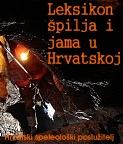
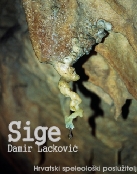


publications
KOMISIJA ZA SPELEOLOGIJU
Hrvatskog planinarskog saveza
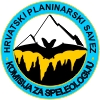

The Speleological Committee
of the Croatian Mountaineering Association
Kozarčeva 22
10 000 Zagreb
Croatia
e-mail:
speleologija@hps.hr
Chairman: Damir
Basara
Deputy: Dalibor Paar, PhD

INTERNATIONAL UNION OF SPELEOLOGY

SPELEOLOGICAL FEDERATION OF THE EUROPEAN UNION

PDF
Statute UIS
PDF
Statute FSE.
FSE
regulations.
PDF
Statute BSU.
PDF
UIS BULLETIN 51-2 / 2008.
PDF
UIS BULLETIN 51-3 / 2008.
PDF
UIS BULLETIN 52-1 / 2009.
PDF
UIS BULLETIN 52-2 / 2010.
PDF
UIS BULLETIN 53-1 / 2012.
PDF
UIS BULLETIN 54-1 / 2012.
PDF
UIS BULLETIN 55-1 / 2013.

|



